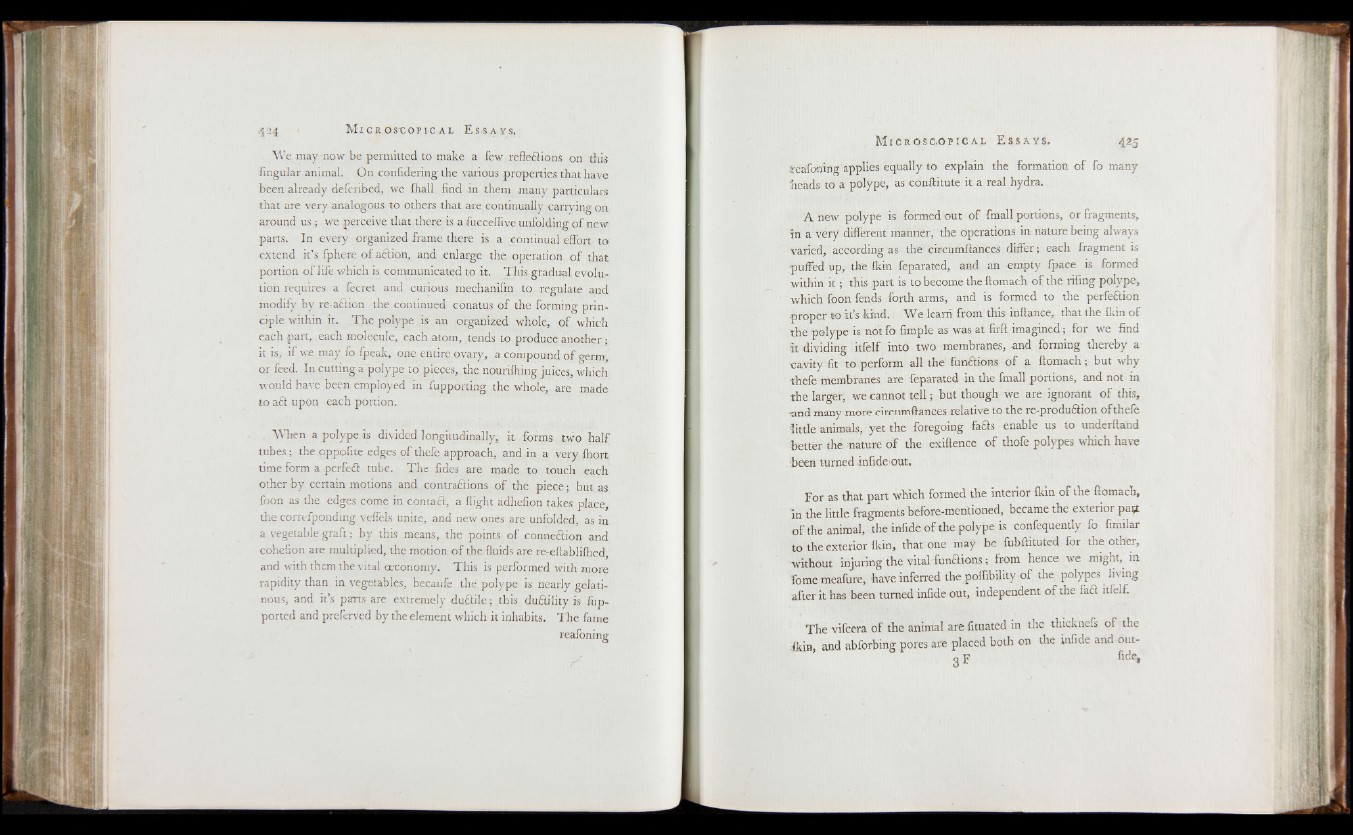
M 424 I C R O S C O P I C A L E S S A Y S .
We may now be permitted to make a few refleftions on this
Angular animal. On confidering the various properties that have
been already defcribed, we fhall find in them many particulars
that are very analogous to others that are continually carrying on
around us ; we perceive that there is afiucceflive unfolding o f new
parts. In every organized frame there is a continual effort to
extend it’s fphere of aftion, and enlarge the operation o f that
portion o f life which is communicated to it. This gradual evolution
requires a fecret and curious mechanifm to regulate and
modify by re-aftion the continued conatus o f the forming principle
within it. The polype is an organized whole, o f which
each part, each molecule, each atom, tends to produce another ;
it is, i f we may 10 fpeak, one entire ovary, a compound o f germ,
or feed. In cutting a polype to pieces, the nourifhing juices, which
would have been employed in fupporting the whole, are made
to aft upon each portion.
When a polype is divided longitudinally, it forms two half
tubes; the oppofite edges of thefe approach, and in a very fhort
time form a perfeft tube. The fides are made to touch each
other by certain motions and contraftions o f the piece; but as
foon as the edges come in contaft, a flight adhefion takes place,
the correfponding veflèls unite, and new ones are unfolded, as in
a vegetable graft; by this means, the points of conneftion and
cohefion are multiplied, the motion o f the fluids are re-eftablilhed,
and with them the vital ceconomy. This is performed with more
rapidity than in vegetables, becaufe thé polype is nearly gelatinous,
and it’s pans are extremely duftile; this duftility is fup-
ported and preferved by the element which it inhabits. The fame
reafoning
111 i
I'ea'foning applies equally to explain the formation of fo many
heads to a polype, as conftitute it a real hydra.
A new polype is formed out of fmall portions, or fragments,
in a very different manner, the operations in nature being always
varied, according as the circumftances differ; each fragment is
puffed up, the fldn feparated, and an empty fpace is formed
within i t ; this part is to become the ftomach of the rifing polype,
which foon fends forth arms, and is formed to the perfeftion
proper to it’s kind. W e learn from this inftance, that the fldn o f
the polype is not fo fimple as was at firft imagined; for we find
it dividing itfelf into two membranes, and forming thereby a
cavity fit to perform all the funftions o f a flomach; but why
thefe membranes are feparated in the fmall portions, and not in
the larger, we cannot te ll; but though we are ignorant o f this,
•and many more circumftances relative to the re-produftion of thefe
little animals, yet the foregoing fafts enable us to underftand
better the nature o f the exiftence o f thofe polypes which have
. been turned infide out.
For as that part which formed the interior fldn of the ftomach,
in the little fragments before-mentioned, became the exterior pa^t
o f the animal, the infide o f the polype is confequently fo fimilar
to the exterior Ikin, that one may be fubftituted for the other,
"without injuring the vital funftions; from hence we might, in
fomemeafure, have inferred the poflibility of the polypes living
after it has been turned infide out, independent o f the faft itfelf.
The vifcera o f the animal are fituated in the thicknefs o f the
fkin, and abforbing pores are placed both on the infide and out-
3 F fides